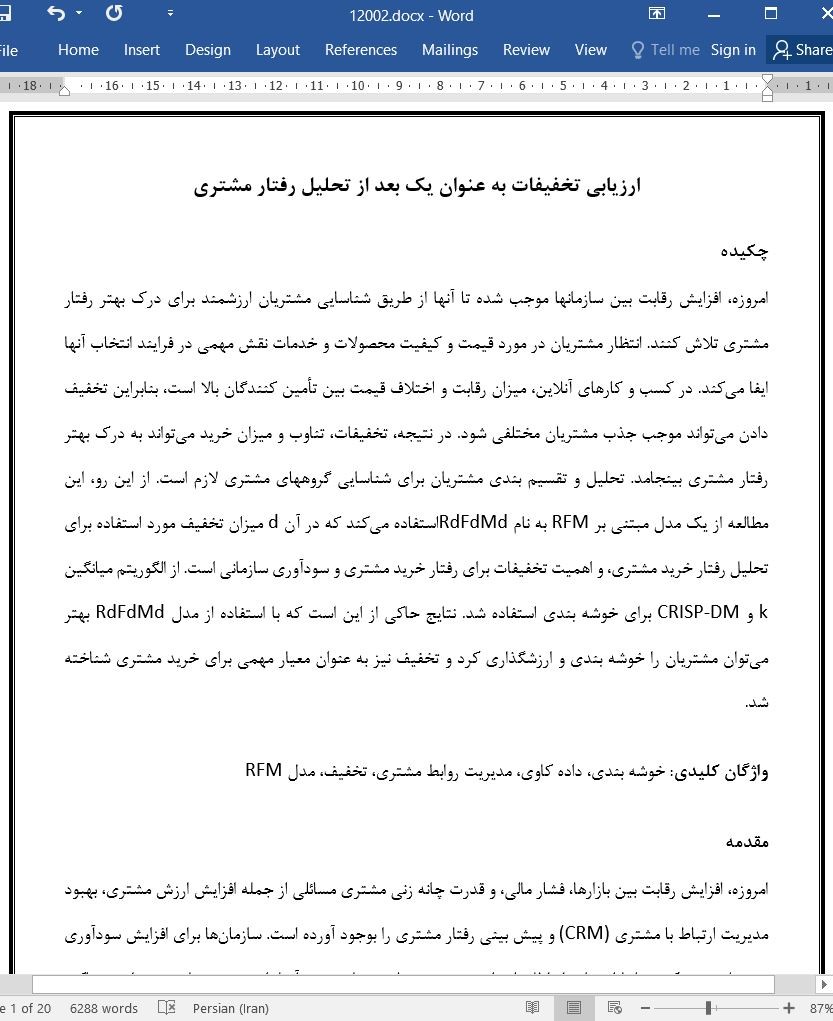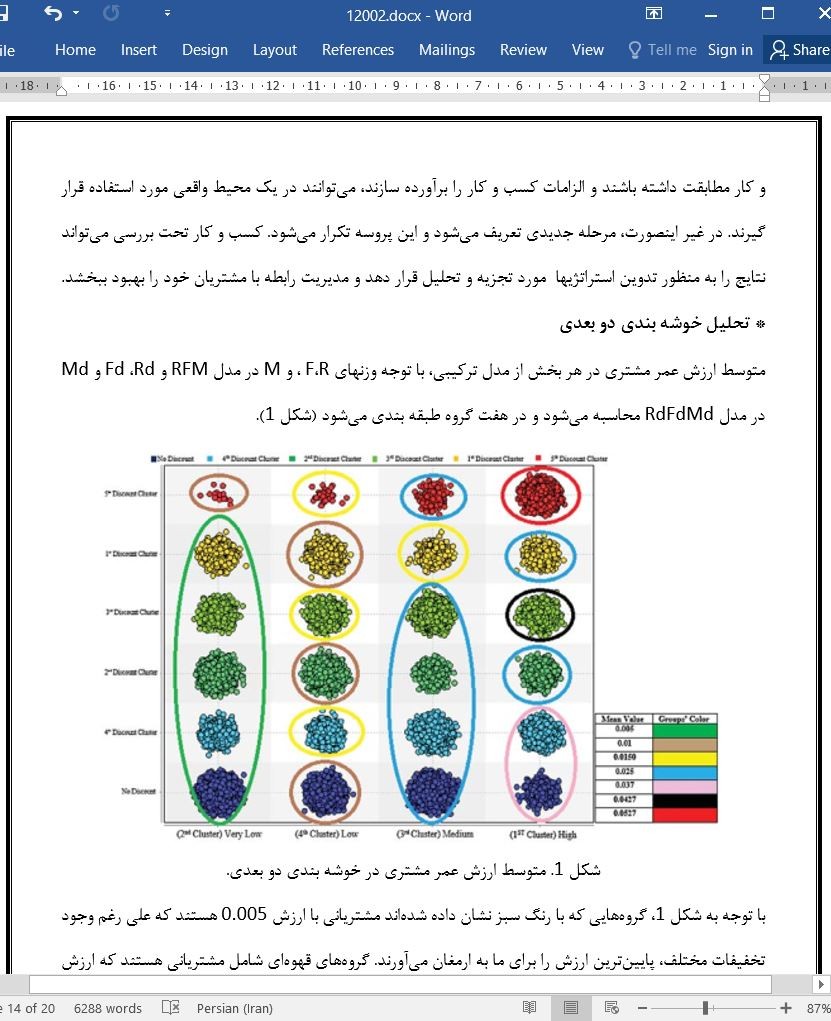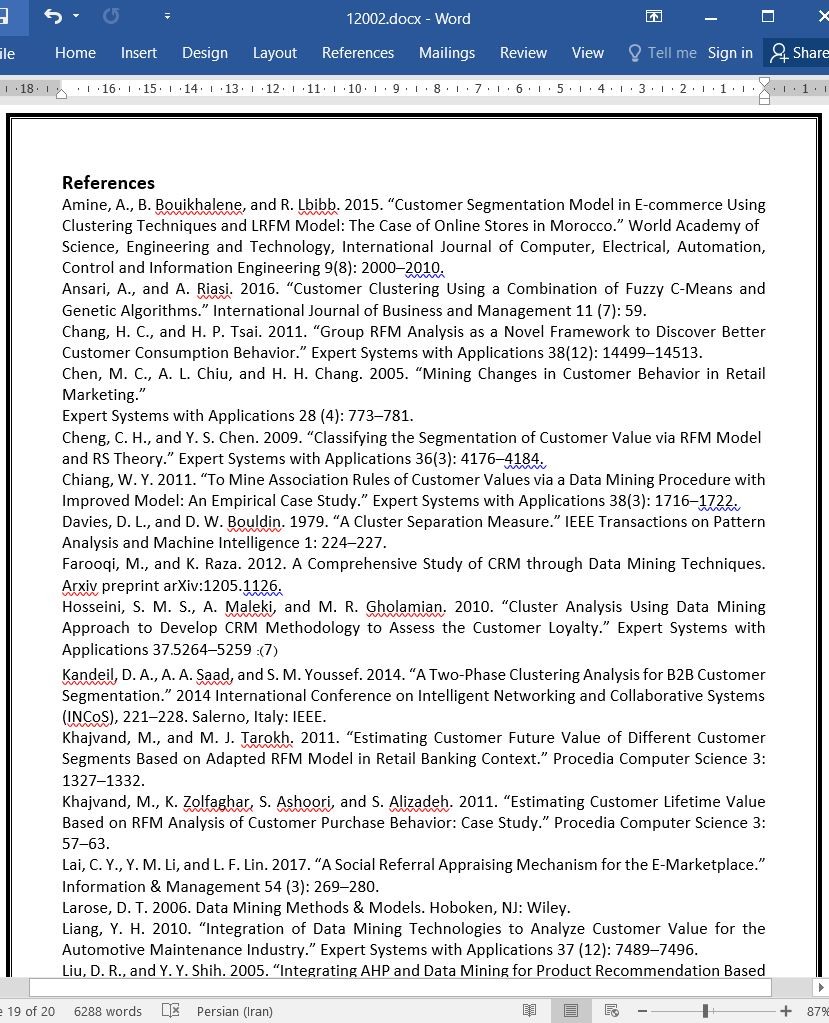
دانلود مقاله ارزیابی تخفیفات به عنوان یک بعد از تحلیل رفتار مشتری
چکیده
امروزه، افزایش رقابت بین سازمانها موجب شده تا آنها از طریق شناسایی مشتریان ارزشمند برای درک بهتر رفتار مشتری تلاش کنند. انتظار مشتریان در مورد قیمت و کیفیت محصولات و خدمات نقش مهمی در فرایند انتخاب آنها ایفا میکند. در کسب و کارهای آنلاین، میزان رقابت و اختلاف قیمت بین تأمین کنندگان بالا است، بنابراین تخفیف دادن میتواند موجب جذب مشتریان مختلفی شود. در نتیجه، تخفیفات، تناوب و میزان خرید میتواند به درک بهتر رفتار مشتری بینجامد. تحلیل و تقسیم بندی مشتریان برای شناسایی گروههای مشتری لازم است. از این رو، این مطالعه از یک مدل مبتنی بر RFM به نام RdFdMdاستفاده میکند که در آن d میزان تخفیف مورد استفاده برای تحلیل رفتار خرید مشتری، و اهمیت تخفیفات برای رفتار خرید مشتری و سودآوری سازمانی است. از الگوریتم میانگین k و CRISP-DM برای خوشه بندی استفاده شد. نتایج حاکی از این است که با استفاده از مدل RdFdMd بهتر میتوان مشتریان را خوشه بندی و ارزشگذاری کرد و تخفیف نیز به عنوان معیار مهمی برای خرید مشتری شناخته شد.
مقدمه
امروزه، افزایش رقابت بین بازارها، فشار مالی، و قدرت چانه زنی مشتری مسائلی از جمله افزایش ارزش مشتری، بهبود مدیریت ارتباط با مشتری (CRM) و پیش بینی رفتار مشتری را بوجود آورده است. سازمانها برای افزایش سودآوری خود تلاش میکنند تا با استفاده از اطلاعات ارزشمند مشتریان و تفاوت بین آنها، ارزش مشتریان خود را به حداکثر برسانند (Chang و Tsai، 2011؛ Farooqi و Raza 2012؛ Khajvand و همکاران، 2011).
مشتریان در مورد قیمت و کیفیت محصولات و خدمات انتظاراتی دارند. انتظارات درباره قیمت نقش مهمی در فرآیند انتخاب مشتریان ایفا میکنند (PK Kannan، 2001). قیمتگذاری برای هر کسب و کار و به خصوص برای خرده فروشان نوپای آنلاین، تصمیم مهمی است (Shim، Choi، و Suh، 2012). قیمتگذاری پویا یکی از استراتژیهای قیمتگذاری است که در آن قیمتها با گذشت زمان تغییر میکنند. نظریههای اقتصادی بر این باورند که قیمتگذاری پویا به طور ذاتی برای سودآوری شرکتها سودمند است، زیرا آن شرکتها را قادر میسازد که مشتریان بیشتری را به دست آورند. قیمتگذاری پویا از طریق بیش فروشی، میزان تخفیف و بسته بندی محصول تعیین میشود (Shim، Choi و Suh، 2012).
ABSTRACT
Today, increased competition between organizations has led them to seek a better understanding of customer behavior through identifying valuable customers. Customers’ expectations about the price and quality of products and services play an important role in their selection process. In online businesses, competition and price differences between suppliers is high, so discounts will attract different customers. As a result, discounts and the frequency and amount of purchases can lead to better understanding of customer behavior. Customer segmentation and analysis is essential for identifying groups of customers. Hence, this study uses a model based on RFM called RdFdMd, in which d is the level of discount used to analyze customer purchase behavior and the importance of discounts on customers’ purchasing behavior and organizational profitability. The CRISP-DM and k-mean algorithm were used for clustering. The results indicate that using the RdFdMd model achieves better customer clustering and valuation, and discounts were identified as an important criterion for customer purchases.
Introduction
Today, increased competition between markets, financial pressure, and customer bargaining power have raised issues such as increasing customer value, improving customer relationship management (CRM), and forecasting customer behavior. To increase their profitability, organizations try to maximize the value of their customers using customers’ valuable information and their differences (Chang and Tsai 2011; Farooqi and Raza 2012; Khajvand et al. 2011).
Customers have expectations about the price and quality of products and services. Price expectations play an important role in consumer choice processes (PK Kannan 2001). Pricing is an important decision for any business, and especially for emerging online retailers (Shim, Choi, and Suh 2012). Dynamic pricing is a pricing strategy where prices change over time. Economic theories argue that the dynamic pricing is inherently good for corporate profitability, because it allows companies to obtain a greater consumer surplus. Dynamic pricing is determined through up-selling, amount of discount and product packaging (Shim, Choi, and Suh 2012).
چکیده
مقدمه
مروری بر مقالات
روش شناسی
تحلیل دادهها
مرحله 1. شناخت کسب و کار
مرحله 2. شناخت و آمایش دادهها
مرحله 4 . مدلسازی
مرحله 5. ارزیابی
مرحله 6. گسترش
بحث و نتیجه گیری
منابع
ABSTRACT
Introduction
Literature review
Methodology
Data analysis
Phase 1. Business understanding
Phases 2 and 3. Data understanding and preparing
Phase 4. Modeling
Phase 5. Evaluation
Phase 6. Deployment
Discussion and conclusion
Disclosure statement
Notes on contributors
References
- اصل مقاله انگلیسی با فرمت ورد (word) با قابلیت ویرایش
- ترجمه فارسی مقاله با فرمت ورد (word) با قابلیت ویرایش، بدون آرم سایت ای ترجمه
- ترجمه فارسی مقاله با فرمت pdf، بدون آرم سایت ای ترجمه



